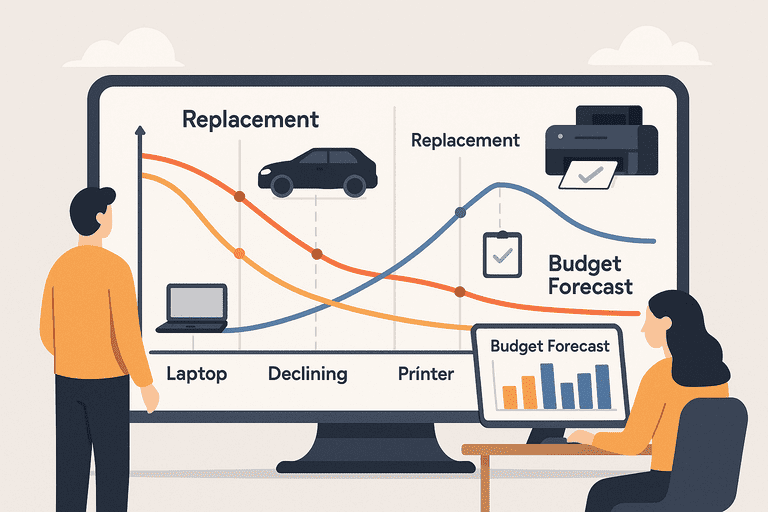Asset Aging & Replacement Models: When to Budget for Refresh
Learn how to plan asset refresh cycles using asset aging and replacement models to optimize costs, reliability, and operational continuity.

Introduction
Every organization faces a key question: when should you replace aging assets?
Keeping old equipment too long increases repair costs and downtime, but replacing too early wastes capital.
Asset aging and replacement models help you strike the right balance — combining data, depreciation, and performance indicators to decide when to refresh your inventory.
In this guide, we’ll break down practical methods to model asset life cycles, assess replacement timing, and plan refresh budgets strategically.
1. Understanding Asset Aging
Asset aging refers to tracking the time elapsed since an asset was purchased or deployed, compared to its expected lifespan.
Each asset has a unique “aging curve” — influenced by:
- Usage frequency
- Maintenance quality
- Environmental conditions
- Manufacturer reliability
By mapping these patterns, you can forecast when equipment performance will decline and costs will rise.
Example Lifespans by Category
| Asset Type | Typical Lifespan | Aging Risk Factors |
|---|---|---|
| Laptops | 3–5 years | Battery wear, software bloat |
| Vehicles | 5–8 years | Mileage, mechanical stress |
| Furniture | 8–10 years | Physical damage, obsolescence |
| Lab Equipment | 5–7 years | Calibration drift, precision loss |
2. The Cost-Benefit Challenge
Organizations often struggle between run-to-failure and planned replacement approaches.
| Strategy | Pros | Cons |
|---|---|---|
| Run-to-Failure | Maximizes use value | Unpredictable costs, downtime |
| Planned Replacement | Predictable budgeting | May retire working assets early |
The key is data-driven replacement — using metrics to identify when maintenance cost surpasses replacement cost.
3. Key Asset Replacement Models
1. Straight-Line Depreciation Model
Assets lose value evenly over time.
Useful for stable, low-maintenance equipment.
Formula:
(Cost - Salvage Value) / Useful Life = Annual Depreciation
2. Declining Balance Model
Assets lose value faster in the early years.
Ideal for technology that rapidly becomes obsolete.
3. Condition-Based Replacement
Uses real-time data such as maintenance history or performance indicators.
Best for assets with variable lifespans, like industrial tools.
4. Total Cost of Ownership (TCO) Model
Adds up all costs — purchase, operation, maintenance, and downtime.
Helps justify proactive replacements for efficiency.
4. Identifying the Optimal Replacement Point
Use cost crossover analysis to find when replacement becomes cheaper than retention.
Example:
If laptop repairs average €200 per year and new models cost €900 with a 4-year lifespan, replacing at year 4 might yield lower long-term costs.
Visualizing this crossover helps you pinpoint the financial sweet spot.
5. Maintenance and Performance Data
Tracking the following indicators helps refine your replacement models:
- Repair frequency (how often assets fail)
- Downtime duration (impact on productivity)
- Energy efficiency trends
- User complaints or performance metrics
Aging assets often show patterns before they fail completely — detecting them early prevents unplanned disruptions.
6. Refresh Budget Planning
A. Categorize Assets
Group assets by function and criticality:
- Critical (e.g., servers, medical devices)
- Standard (e.g., laptops, monitors)
- Low-priority (e.g., furniture)
B. Assign Replacement Thresholds
Define rules like:
- Replace laptops every 4 years
- Replace printers after 30,000 pages or 3 repairs
- Replace vehicles after 6 years or 100,000 km
C. Create a Rolling Refresh Schedule
Instead of replacing everything at once, spread replacements evenly to balance budgets over multiple quarters or fiscal years.
7. Communicating the ROI of Replacements
Finance teams respond to data — not intuition.
Support your refresh proposal with:
- Cost comparison tables (repair vs. replacement)
- Downtime loss estimates
- Residual value of retired assets
- Improved efficiency metrics
A structured model builds trust and simplifies budget approvals.
8. Building Predictive Insights
Advanced analytics tools can:
- Forecast replacement timelines
- Track performance degradation
- Trigger alerts when costs exceed thresholds
Even without AI, structured maintenance data and asset logs can yield strong predictive insights over time.
Conclusion
Asset aging and replacement modeling ensures that every refresh decision is informed, timely, and cost-effective.
By monitoring lifecycle data, understanding depreciation, and applying replacement thresholds, your organization can reduce downtime and optimize capital investment — without waste.
Explore more lifecycle and maintenance insights: